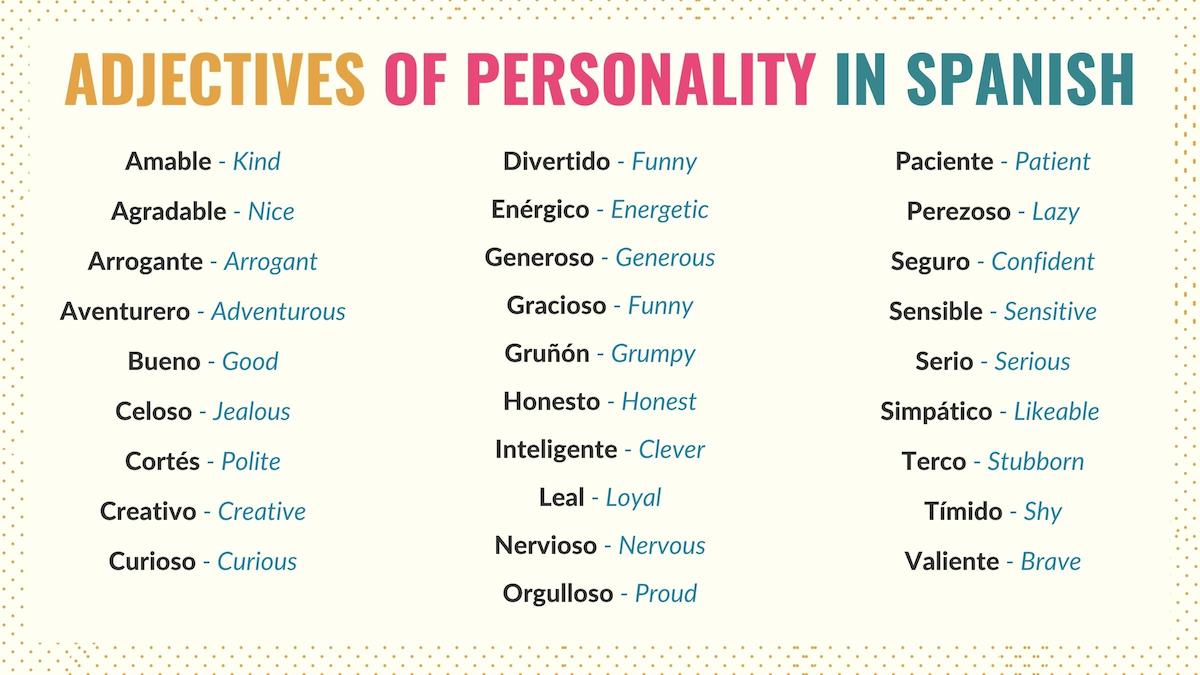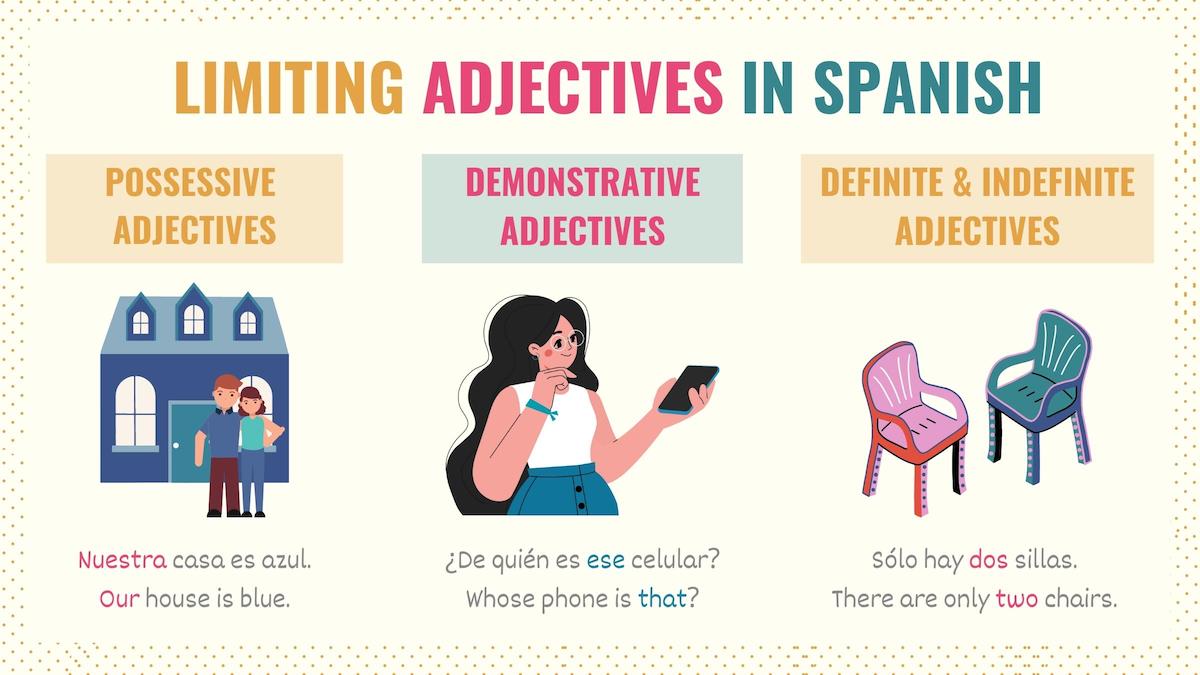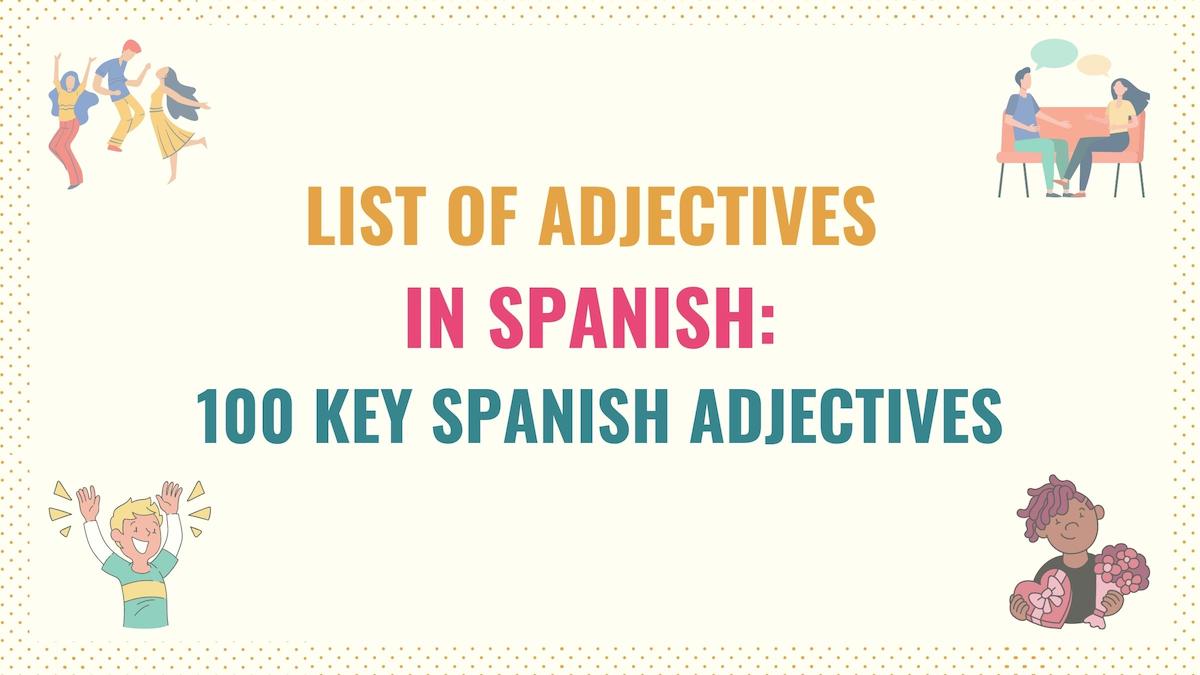Spanish adjectives are one of the essential building blocks of a sentence. After all, this part of speech allows you to identify and describe people, places, things, and ideas. Since they can help you enrich your vocabulary and communication, in this guide, you’ll find a list of adjectives in Spanish you must know.
Here is an overview of what we’ll cover:
- Spanish Adjectives to Describe People & Things
- Limiting Adjectives
- Next Steps: Resources to Learn Spanish Adjectives
By the end of this, you’ll know basic words to describe anything you want in Spanish.
List of Common Spanish Adjectives to Describe People & Things
A descriptive adjective in Spanish is a word that describes a noun’s attributes or characteristics. In simple terms, these adjectives communicate how something or someone is. Some of the qualities they describe are:
- Color
- Size
- Nationality
- Shape or texture
- Physical attributes
- Personality
As you’ll learn, this type of adjective is usually placed after the noun. In the sections below, you’ll find the most common Spanish adjectives to describe things. Click on the following links to find specific guides about adjectives of color and nationalities.
Food adjectives in Spanish
Here is a list of essential words to describe dishes and food in Spanish.
- Agrio: Sour
- Amargo: Bitter
- Azucarado: Sugary
- Caliente: Hot
- Cremoso: Creamy
- Crudo: Raw
- Crujiente: Crunchy
- Delicioso: Delicious
- Dulce: Sweet
- Duro: Hard
- Frío: Cold
- Frito: Fried
- Fresco: Fresh
- Graso: Fatty
- Congelado: Frozen
- Caliente: Hot
- Jugoso: Juicy
- Ligero: Light
- Maduro: Ripe
- Nutritivo: Nutritious
- Oloroso: Smelly
- Orgánico: Organic
- Picante: Spicy
- Salado: Salty
- Sabroso: Tasty
- Seco: Dry
- Suave: Soft
La carne estaba cruda.
The meat was raw.
Estos son huevos orgánicos.
These are organic eggs.
Ten cuidado, la sopa está muy caliente.
Be careful; the soup is very hot.
Las verduras son muy nutritivas.
Vegetables are very nutritious.
Take Note: Past participles in Spanish can also work as adjectives. Because they describe the state of something, past participles can be used to describe food.
Me gustan las galletas quemadas.
I like burnt cookies.
List of Spanish Adjectives of personality

Below are the most common adjectives of personality in Spanish. These words are often combined with the verb ser or parecer.
- Amable: Kind
- Agradable: Nice
- Arrogante: Arrogant
- Aventurero: Adventurous
- Bueno: Good
- Celoso: Jealous
- Cortés: Polite
- Creativo: Creative
- Curioso: Curious
- Divertido: Funny
- Enérgico: Energetic
- Generoso: Generous
- Gracioso: Funny
- Gruñón: Grumpy
- Honesto: Honest
- Inteligente: Clever
- Leal: Loyal
- Nervioso: Nervous
- Orgulloso: Proud
- Paciente: Patient
- Perezoso: Lazy
- Seguro: Confident
- Sensible: Sensitive
- Serio: Serious
- Simpático: Likeable
- Terco: Stubborn
- Tímido: Shy
- Valiente: Brave
Here are some sentences:
Eres una niña muy valiente.
You’re a very brave little girl.
Tus amigas son muy graciosas.
Your friends are very funny.
El novio de Mónica es muy celoso.
Monica’s boyfriend is very jealous.
Los chicos nuevos parecen amables.
The new guys seem nice.
Necesito que seas un poco más paciente.
I need you to be a little bit more patient.
Take Note: Keep in mind that Spanish adjectives must agree with the gender and number of the noun they’re describing. For the most part, feminine adjectives end with an ‘a’ and masculine adjectives with an ‘o’. Check the Spanish gender rules to learn how to change these words.
Spanish Adjectives to Describe Physical Appearance
In this list, you’ll find common words you can use to describe something or someone’s physical attributes.
- Alto: Tall
- Atlético: Athletic
- Bajo: Short
- Bonito: Pretty
- Calvo: Bald
- Delgado: Thin
- Débil: Weak
- Feo: Ugly
- Flaco: Skinny
- Fuerte: Strong
- Gordo: Fat
- Grande: Big
- Guapo: Handsome
- Hermoso: Beautiful
- Joven: Young
- Liso: Straight
- Musculoso: Muscular
- Ondulado: Wavy
- Pálido: Pale
- Pequeño: Small
- Rizado: Curly
- Rubio: Blonde / Blond
Ellas tienen cabello rubio y rizado.
They have blonde and curly hair.
Mi perro es pequeño y gordo.
My dog is fat and small.
Ava es pálida y tiene ojos azules.
Ava is pale and has blue eyes.
El coche nuevo es muy bonito.
The new car is very pretty.
Me siento muy débil.
I feel very weak.
Take Note: When describing someone or something’s component (like hair or body parts), you should use the verb tener or possessive adjectives.
List of Spanish Adjectives for Clothing
Spanish adjectives can also help us describe the appearance as well as the experience of the clothes we wear. Below is a list some popular adjectives you can use to talk about clothes and accessories:
- Ajustado / Apretado: Tight
- Arrugado: Wrinkled
- Chico: Small
- Colorido: Colorful
- Cómodo: Comfortable
- Corto: Short
- Elegante: Elegant / Classy
- Flojo: Loose
- Fresco: Cool
- Grande: Big
- Incómodo: Uncomfortable
- Informal: Casual
- Largo: Long
- Limpio: Clean
- Liso: Smooth / Plain
- Ligero: Light
- Nuevo: New
- Pesado: Heavy
- Rayado: Striped
- Sucio: Dirty
- Suave: Soft
- Viejo: Old
Esta camisa es nueva.
This shirt is new.
Necesito un vestido más largo.
I need a longer dress.
La bufanda es muy suave y cómoda.
The scarf is very soft and comfortable.
Esos zapatos me quedan muy apretados.
Those shoes are too tight on me.
Just like other types of nouns, clothing can also have gender and number. Notice how in the examples, these Spanish adjectives match the gender and plurality of the Spanish words for clothing.
Spanish Grammar: Limiting Adjectives in Spanish

In Spanish, limiting adjectives (also called determiners) specify the noun they modify. Unlike descriptive Spanish adjectives, this type of word doesn’t refer to qualities but rather to possession, proximity, or quantity.
Because they modify and specify nouns, this type of adjective must always be placed before nouns and can be transformed into Spanish pronouns.
Examples of limiting adjectives are:
1. Spanish possessive adjectives
They convey who owns something. Mi, mis, tu, tus, su, sus, nuestro, and nuestra are some examples of Spanish possessives.
Nuestra casa es azul.
Our house is blue.
Tus amigas hablan inglés.
Your friends speak English.
Take Note: The possessive adjectives for nosotros and vosotros are the only ones that mark gender.
2. Demonstrative adjectives
Demonstratives in Spanish specify the distance between the speaker and a noun. Este, ese, and aquel are demonstrative adjectives.
Esta galleta es tuya.
This cookie is yours.
Aquel perro me mordió.
That dog bit me.
¿De quién es ese celular?
Whose phone is that?
Notice that demonstrative adjectives in Spanish mark both gender and number.
3. Definite & Indefinite adjectives
These adjectives are also known as quantifiers. As their name suggests, they’re meant to specify the amount of something. Definite adjectives are numbers that refer to a specific amount, such as:
Sólo hay dos sillas.
There are only two chairs.
Imprimimos trescientos boletos.
We printed three hundred tickets.
On the other hand, indefinite adjectives in Spanish refer to amounts in a more imprecise way. Some examples of these words include:
- Algunos: Some
- Mucho: A lot / Many
- Ningún: No / Any
- Poco: Little / Few
- Todo: All / Every
Hay muchas personas.
There are many people.
Julia compró algunos plátanos.
Julia bought some bananas.
Next Steps: Resources for Learning Spanish Adjectives
Now that you’ve learned common adjectives in Spanish, here are some links to help you improve your command of this topic. Since they only work with those words, you should check what Spanish nouns are and how they work.
As you probably saw, an adjective can come either before or after the noun. The adjective placement rules can help you understand when and where to place these words correctly. Spanish adjectives always mark the number, and sometimes the gender, of a noun. As a result, check how to make plural words and how the grammatical gender works.
While knowing each list of adjectives above is important, there are different types of adjectives in Spanish. Check out the full guide to Adjectives to learn about the different types, rules and examples. It can help you understand how this list fits into the larger context of the language.
Finally, remember that you can also use an adjective in comparative and superlative structures.
Download the Spanish Adjective List PDF
Spanish adjectives are a must-know when learning to speak the language. They help you enrich the meaning and descriptiveness of your sentences. You can download a PDF copy of the Spanish adjectives list so you can incorporate this vocabulary at your own pace as you learn Spanish. Just like this guide, I’ve broken the adjectives into separate lists by type to make them easier to navigate.





